Weapons
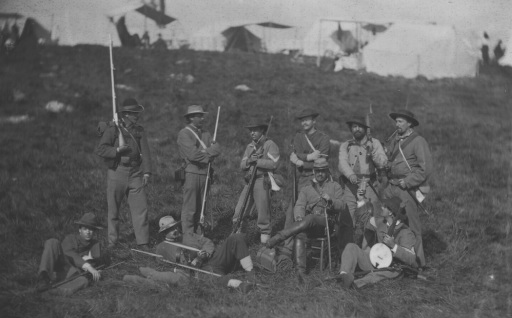
The 49th Virginia, shown here, was in the same brigade as the 25th Virginia.
The Upshur Grays were not issued weapons until several days after they were sworn into Confederate service on May 27, 1861. Some brought shotguns or muzzle-loading flintlocks from home when they were first sworn into state service on May 7, and nearly all carried some sort of knife. It wasn’t until they arrived at Philippi on June 2 that they received government-issued shoulder arms. These were old flintlocks converted to fire with percussion caps, and a handful of Grays had to be content with flintlocks that still required a flint chip to spark the powder charge. The converted flintlocks used a .69-caliber bullet dropped into the muzzle of the barrel on top the powder charge and tamped down with a ramrod. Such were the weapons the Upshur Grays carried through much of 1861, including the battles at Rich Mountain in July and at the Greenbrier River in October.
Muskets (Rifles)

The .58-caliber Springfield rifle, carried by the 25th Virginia, 1861-1864.
By the time of the Allegheny Mountain battle on Dec. 13, 1861, the Grays had received more reliable rifled muskets that fired the standard .58-caliber “minie ball.” During the war, the Grays were armed with a variety of weapons, but usually carried the American-made Springfield rifle commonly used by Union troops as well. Early in 1864 Col.John Higginbotham arranged to have the 25th Virginia supplied with British-made Enfield rifles of .577-caliber. The Enfield used the standard .58-caliber bullet, though it could cause jamming problems if the barrel were not cleaned frequently. A few members of the regiment were given British-made Whitworth rifles, used mainly by sharpshooters. The 25thVirginia was renowned for marksmanship and had special training after acquiring the British-made arms.
Each of the rifled muskets weighed more than 9 pounds (the Springfield was 9 and three-quarter pounds and the slightly shorter Enfield was 9 and a quarter pounds). With bayonet attached, the rifle was taller than the soldier carrying it. The Springfield was 56 inches long and, with bayonet, extended to 74 inches. Similar figures for the Enfield were 55 and 73 inches. The Whitworth was only 49 inches in length, weighed 9 pounds, and fired a special .45-caliber bullet. Its recoil could leave the shooter with a black eye.
Cartridges and Caps
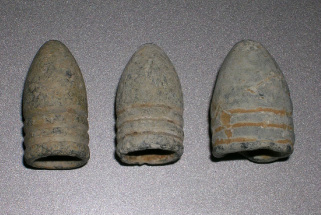
.58-caliber (left and center) and .69-caliber (right) minie balls.
Early in the war many Civil War soldiers, Confederate and Union, were armed with single-shot smooth-bore muskets that fired a round lead ball. Through most of the war, however, most were armed with rifled muskets that used the .58-caliber bullet called the “minie ball” after French army inventor C.E. Minie. This was actually not a ball but a conically shaped hollow-base lead bullet that gained accuracy and power as it spun through the rifled barrel. Thus, the rifled musket was far superior to the smooth-bore in accuracy and distance.
Smooth-bores were effective at short range but notoriously inaccurate at distances of more than 150 yards. The rifle was effective up to 500 yards and, according to the type of weapon and the ability of the soldier firing it, sometimes beyond 1,000 yards. Unfortunately for the Civil War infantryman, tactics used in previous wars (based on smooth-bore weapons) still were in vogue in the 1860s. That included mass attacks of a mile or more by men vulnerable much of the distance to rifled muskets as well as artillery. As the war went on, the attackers also were going against defending troops well dug in behind embankments and other barricades.
Loading the rifle was an intricate process.
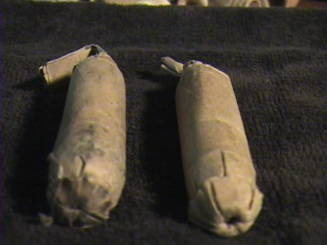
The soldier would take a paper-wrapped cartridge containing both bullet and powder, tear the paper away (most often using his teeth), pour the powder into the barrel, then drop the bullet (point facing the barrel opening) and tamp it down with the ramrod normally attached to the bottom of the barrel. He then placed a percussion cap on a “nipple” in front of the hammer. When struck by the hammer, the cap shot a spark into the barrel, setting off the powder there and firing the bullet. This allowed firing of the rifle even in rainy or snowy conditions. An experienced soldier could get off three or more shots per minute.
Most Confederate soldiers did carry a small cap pouch (shown below) attached to the belt.
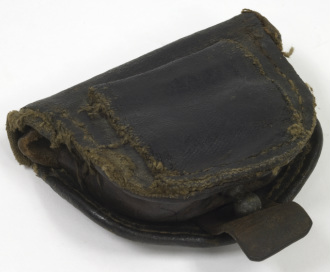
A few Confederates also carried the larger cartridge box commonly used by Union troops. When issued cartridges preceding a battle (normally 20 to 40 rounds), most Confederate soldiers would stuff them into their haversacks and pockets.
Bayonets
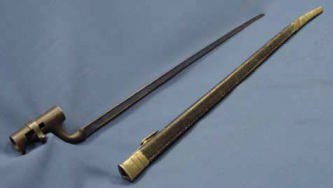
Confederate authorities eventually supplied bayonets to infantrymen. Most were long metal bars that tapered to a sharp point at the front. The bayonet was carried in a holder or sheath fastened to the belt, and was attached over the rifle barrel when in use. Many soldiers threw their bayonets away as cumbersome and excess baggage that also could interfere with loading the rifle. Most soldiers found that a clubbed musket (swinging at the enemy stock first while holding the barrel) was as effective as a bayonet in hand-to-hand fighting. Those who kept the bayonet, however, not only could use it in close combat but found that it made a good candle holder as well. Thrusting it point first into the ground left the socket that fit over the
barrel in perfect position to hold a candle.
barrel in perfect position to hold a candle.
Knives
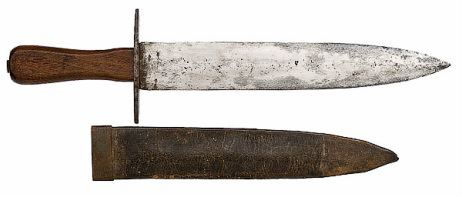
Confederate Bowie Knife (sold by Cowan's Auctions, 2008 Fall Firearms Sale, for $2,160.00).
Nearly every Confederate soldier had a knife, ranging from a large bowie-style intended for combat to pocket knives. Some of the larger knives were eventually thrown away as the soldier realized they were virtually worthless in combat and could be unwieldy or even dangerous to carry. Most kept some kind of knife, however, for multiple uses (including food preparation).